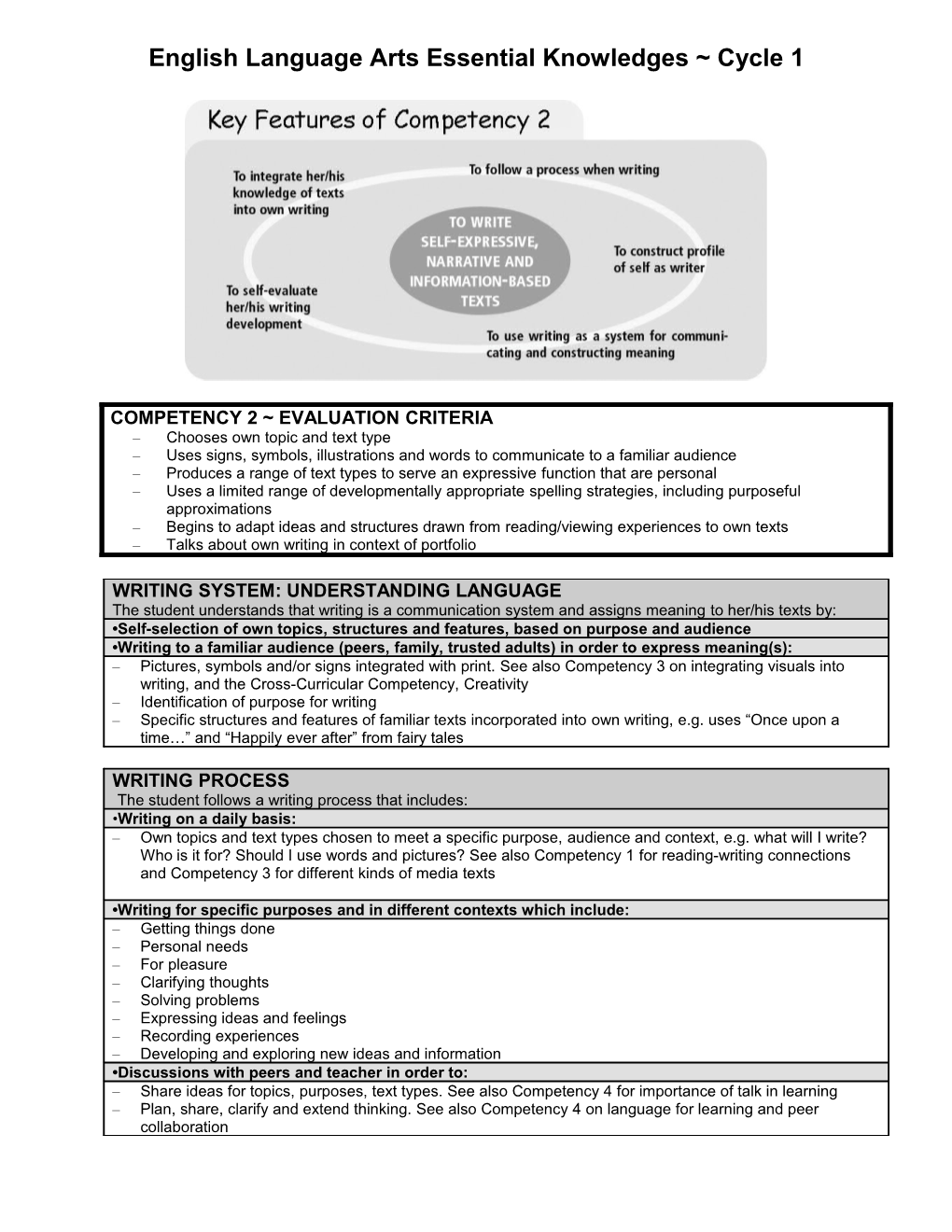English Language Arts Essential Knowledges ~ Cycle 1
–Chooses own topic and text type
–Uses signs,symbols,illustrations and words to communicate to a familiar audience
–Produces a range of text types to serve an expressivefunction that are personal
–Uses a limited range of developmentally appropriatespelling strategies,including purposeful approximations
–Begins to adapt ideas and structures drawn fromreading/viewing experiences to own texts
–Talks about own writing in context of portfolio
WRITINGSYSTEM: UNDERSTANDINGLANGUAGE
The student understands that writing is a communication system and assigns meaningto her/his texts by:
•Self-selection of own topics,structures and features,based on purpose andaudience
•Writing to a familiar audience (peers,family,trusted adults) in order toexpress meaning(s):
–Pictures,symbols and/or signs integrated with print.See alsoCompetency 3 on integrating visuals into writing,and theCross-Curricular Competency,Creativity
–Identification of purpose for writing
–Specific structures and features of familiar texts incorporated intoown writing,e.g.uses “Once upon a time…”and “Happilyever after”from fairy tales
WRITINGPROCESS
The student follows a writing process that includes:
•Writing on a daily basis:
–Own topics and text types chosen to meet a specific purpose,audience and context,e.g.what will I write? Who is it for?Should I use words and pictures? See also Competency 1for reading-writing connections and Competency 3 for differentkinds of media texts
•Writing for specific purposes and in different contexts which include:
–Getting things done
–Personal needs
–For pleasure
–Clarifying thoughts
–Solving problems
–Expressing ideas and feelings
–Recording experiences
–Developing and exploring new ideas and information
•Discussions with peers and teacher in order to:
–Share ideas for topics,purposes,text types.See also Competency 4for importance of talk in learning
–Plan,share,clarify and extend thinking.See also Competency 4on language for learning and peer collaboration
• Exploratory prewriting activities appropriate to purpose, audience and context for writing:
–Brainstorming for information and asking questions
–Drawing on ideas,prior experiences and personal memories
–Drawing,planning,talking
–Reading,listening to,viewing and talking about stories,songs,poems and books
–Using graphic organizers
–Telling and retelling stories
–Drawing on prior knowledge,e.g.of the media.See also respondingand production processes in Competency 3
•Writing activities that nourish the development of a process for producingwritten texts:
–Regular,sustained time to write on a daily basis
–Drafts of own writing with focus on making meaning
–Rereading of own writing with focus on meaning
–Sharing own writing with peers
–One or two strategies for crafting and revising own writing,on atrial-and-error basis:
-Talking about own writing
–Self-edits with focus on a limited number (1 or 2) of writingconventions at own developmental level:
-Checks for end punctuation in pairs by reading aloud
–Re-presentation of personally meaningful texts as published piecesfor intended familiar audience
KNOWLEDGEOFTEXTS: READING-WRITINGCONNECTIONS
The student comes to understand that texts are social and cultural products by:
•Experimentation with familiar structures and features of different text typesin own writing:
–Based on wide repertoire of texts read,viewed in the media andencountered in her/his community
–To suit own purpose and audience
•Development of understanding of writing conventions which include grammar (sentence structure and syntax),usage (agreement and word choice)and mechanics (spelling,capitalization and punctuation):
–Development of spelling conscience:rules,generalizations andpatterns of written language,i.e.spelling,applied at appropriatedevelopmental level
–Growing repertoire of developmentally appropriate spellingstrategies:
-Approximations,phonetic representation,visual patterns andcommon letter sequences,common structural patterns
PROFILE OFSELF ASWRITER
The student develops profile of self as writer in the context of a community of writers inthe classroom by:
•Writing daily for personally significant purposes:
–See Writing Process—purpose and context for writing,above
•Personal contribution to the development of a writing community in theclassroom through:
–Connections made between reading,writing and interactions withpeers,risk-taking in order to learn the writer’s craft,decisions madeabout own writing
–Repertoire of favourite self-expressive,narrative andinformation-based text types reflects reading,listening,viewing,visual representations and writing.See also Competency 1 and 3for text types
SELFEVALUATION
The student learns to apply her/his knowledge about language and texts deliberately,consciously and with increasing control and enjoyment,on the basis of conversationswith teacher and peers about her/his writing that involve:
•An integrated ELA portfolio:
–Sharing of portfolio with teacher in order to talk and reflect aboutwriting on a regular basis throughout cycle
–Focus on pleasure taken in writing and in discussion with teacherand peers.See Competency 4 for use of team strategies and talkin learning
–Student-initiated talk about some writing strategies and aboutfavourite pieces of writing with teacher
–Organization of written texts,i.e.with guidance in Cycles One andTwo.See also other competencies in this program
